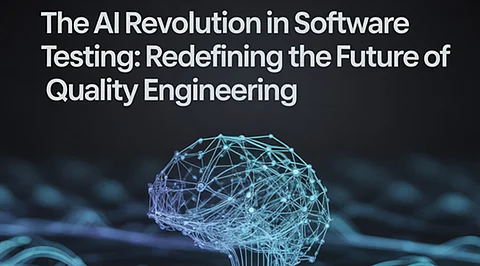

In today’s digital age, Vikram Sai Prasad Karnam, a renowned technology expert and author, explores the transformative role of artificial intelligence in software testing. He highlights the shift from conventional approaches to AI-driven, machine learning-powered test automation, marking a new era in testing methodologies focused on speed, accuracy, and intelligent adaptability.
Gone are the days when testing was merely a reactive process. One of the most profound innovations in AI-driven testing is the capability to predict potential defects before they surface in production. Using predictive analytics, AI systems analyze historical defect data, code complexity, and test execution patterns to flag high-risk areas. The result? A 35–45% increase in identification of critical defects ahead of release, and a 20–30% decrease in post-release issues. This shift towards preventive quality assurance enhances both reliability and customer trust.
A major hurdle in conventional test automation has been the constant upkeep of test scripts—especially in dynamic UI environments. AI addresses this through self-healing test automation. These systems automatically detect changes in user interface elements and adapt locators without human intervention. Notably, organizations deploying such frameworks have reported a 40–60% reduction in maintenance efforts and a 30–45% drop in execution failures. The efficiency and resilience of these self-correcting scripts significantly reduce technical debt and free up resources for innovation.
Manually crafting test cases is often laborious and limited in scope. AI-based solutions, however, use genetic algorithms and natural language processing to generate comprehensive test scenarios. This leads to enhanced functional coverage—up by 25–35%—and drastically reduced authoring time. These intelligent systems analyze application behavior, interpret requirements, and produce high-coverage test suites with precision. It’s a leap toward quality assurance that scales with the speed and complexity of modern software development.
AI-driven testing is not just a technical enhancement—it’s a strategic financial decision. By leveraging risk-based testing, organizations are identifying 80–90% of critical defects while executing just 30–40% of their test suites. This optimized approach translates to 30–45% reductions in testing time. Furthermore, the integration of AI slashes quality assurance costs by up to 25% and helps companies realize ROI within 6–12 months. Infrastructure costs also drop as intelligent orchestration minimizes resource waste during testing cycles.
The true potential of AI in testing reveals itself when integrated with continuous integration/continuous deployment (CI/CD) pipelines. AI-powered automation selects test cases dynamically, provisions test environments ahead of code delivery, and enables parallel execution. These integrations reduce deployment cycles by up to 35% while boosting quality. Moreover, automated quality gates enforce standards in real-time, and continuous learning systems evolve based on historical testing patterns, improving effectiveness by 15–30% in the first six months alone.
Despite its advantages, AI-driven testing faces adoption hurdles. A lack of skilled professionals, with over 70% of QA teams reporting expertise gaps, is a major barrier. High initial investment—ranging from $250,000 to $1.5 million—also poses a concern, particularly for mid-sized organizations. Integration complexities and cultural resistance further slow down adoption. Yet, phased implementation strategies, executive backing, and emerging cloud-based solutions are beginning to bridge these gaps.
Going forward, test generation using natural language processing and creating systems that would let autonomous testing happen are the most exciting evolutions. Systems employing NLP are now able to take requirement documents and turn them into test scripts that one can run on the application with increasing accuracy, while autonomous systems will soon have the capacity to uncover application behaviors and validate them on their own. This, in turn, would cut the application test generation time by as much as 60% and halve the costs of quality assurance.
In conclusion, Vikram Sai Prasad Karnam envisions not-so-distant-future, in which quality assurance will not be an entirely separate stage, but rather an invisible, intelligent function embedded somewhere in the software development lifecycle. If the testing capabilities are installed within development environments, the line between coding and quality assurance is blurred. Real-time feedback, AI-powered code analysis, and predictive quality insights offered by modern platforms have made development faster, reliable, and cost-effective. AI will not just enhance testing; it will transform testing. Through adapting this change, organizations will be able to not only deliver better software to the customer but will also gain an edge in the fast-changing digital space.
